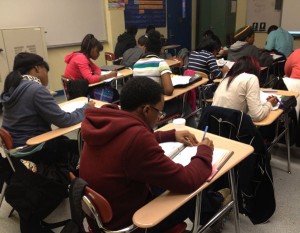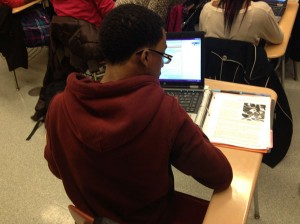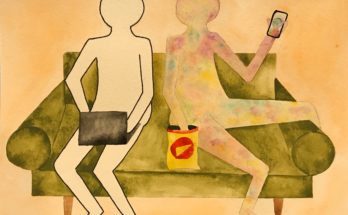The sound of clicking keyboards filled the otherwise quiet classroom in Crown Heights, Brooklyn. More than 20 ninth grade students sitting in rows of desks worked on reading-comprehension drills on individual laptops, as their teacher, Junghyun Kym, walked around the room and crouched to speak quietly to students wanting help.
Kym’s English class is at a new public school where students earn an associate’s degree in computer systems or electromechanical engineering after their high school diploma. The school is part of a network of New York City public schools, called the iZone, which make technology a critical part of their curriculum. Instead of using pens, papers and highlighters to master the second semester curriculum, which includes learning to build arguments and synthesize evidence from non-fiction material, the students at Pathways in Technology Early College High School use laptops in the classroom. But it’s not only that the students are learning digitally — they are each working on drills at different reading levels. Software implemented in the classroom, through the iLearnNYC branch of the iZone, adjusts similar content to different reading levels and gives students instant feedback on their progress.


Justin Hoppie, 14, one of the ninth grade students in Kym’s class, learns on Achieve 3000, an online reading program and WriteToLearn, an online essay platform. Having the computer drills at the beginning of class is helpful, he said. “It warms you up.”
At his old school, Roy H. Mann Junior High School in Brooklyn, Hoppie only used paper in class, and did not like to read books as much. Now, attending a school that partners with IBM, the City University of New York, and New York City College of Technology, he finds that his love of electronics makes him enjoy learning on the computer more than on paper. But Hoppie, who wants to be an automotive engineer, acknowledged that computers could be source of a distraction, because they provide easy access to sites such as Facebook.
Kym’s classroom is one in many schools across the country incorporating technology into the curriculum. In New York City alone, there are almost 250 schools in the iZone network, which began in 2010. Since the technology is relatively new, there is little long-term research on how well technology-assisted learning works. The iZone does have a research team that will help determine the results of the iLearn program down the road, said Mallory Hauser, special assistant at the Office of Innovation at the New York Department of Education.
Educators don’t even agree on what to call this type of instruction. The term “blended learning” is trendy but not universally accepted. Blended learning means a shift in the classroom’s use of time and place, said James Lerman, professor of educational leadership at Kean University in New Jersey. For example, blended learning could mean watching a lecture at home and then discussing it in the classroom, such as in the “flip classroom.” He labels classrooms that use technology to personalize students’ learning experiences “differentiation.”
The classes at Pathways in Technology use many different media to make material accessible to students. After students finished their drills in Kym’s class, they voted on whether to play Lil’ Wayne’s “How to Love,” a song Kym used as an exercise. Most students raised their hands, so Kym played the video, which projected the lyrics onto the smart board. Students followed along on their paper copies of the lyrics as the song blasted from speakers. The students pulled out evidence to support the speaker’s thesis, that the woman in the song never learned how to love as a result of her life circumstances. They then discussed their answers with classmates and with the teacher. Afterwards, it was time to move from the fun exercise to using the technique on their essays.
“If you have a topic sentence, that topic sentences has to be supported by the evidence,” Kym told the class in a strong, clear voice. She then instructed the students to log onto the online platform iLearn where they were to include quotes to support the arguments in their essays on teenagers having plastic surgery. The students turned on their computers, and started working.
Wearing a maroon sweatshirt and black-and-white glasses, Hoppie balanced his silver laptop on top of one side of his binder on his desk. He read a paper copy of the article and then typed in quotes into the computer system. He said that he is enjoying writing his essay on the downsides of plastic surgery and that teenagers should accept themselves as they are.
Since the program adjusts content to different skills levels, the students in the classroom work at their own pace, and Kym can help individual students. The software pinpoints specific skill levels, said Kym. “They get this automatic feedback on what they need to work on,” she said. She then reads their essays and writes her notes in the computer system for students to review.
The system shows students their progress by saving all the drafts of their essay in one system, and has an organizational upside: “They won’t lose the paper,” said Kym.
The technology-assisted classroom may produce more data than one that uses paper and pencils, as computer programs track and save student work. “Teachers are able to use observational data much more easily in this environment,” said Michael Horn, executive director of the Innosight Institute, which champions technology in the classroom, and co-author of the 2008 book “Disrupting Class: How Disruptive Innovation will Change the Way the World Learns.”
The new technology is reorganizing the classroom, according to Britt Neuhaus, iZone support staff member. The iLearnNYC, online management platform, used in schools such as Pathways in Technology, allows teachers to set up different digital discussion forums and dropboxes for personal and group work, she said. “It’s really allowing for students to stay organized and utilize a lot more resources than they would have without the Internet,” said Neuhaus.
Schools in the iZone are just one example of how schools across the country are using technology. Lerman, the professor of educational leadership at Kean University, said that there has been an acknowledgement that new learning methods can help students reach their potential, but there are so many tools available today that it can be difficult to choose the most effective one. The right tools also depend on what the teacher wants to achieve in the classroom. “It depends so much on the situation and the people and what the needs are,” he said.




Wow. I hope it will be okay for her, too.
Thanks a lot
I feel honored to have a article about me